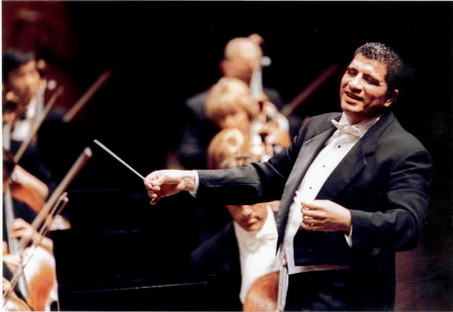Cleveland Orchestra, violinist shine in Romantic program

Giancarlo Guerrero
Just days after Giancarlo Guerrero was named principal guest conductor of the Cleveland Orchestra’s Miami residency, he took the podium to lead the orchestra at the Arsht Center. The ensemble played extremely well, although the program was so dominated by warhorses that most members of the orchestra have probably played these pieces dozens of times.
Guererro, music director of the Nashville Symphony, displayed an easygoing manner and a musical intensity that should serve him well as he becomes the public face of the orchestra’s winter series of concerts, community events and educational programs. In a pre-concert talk, Guerrero wore his musical erudition lightly, talking about Mendelssohn’s letters to the violinist who would premiere his violin concerto, singing bits of Elgar’s Enigma Variations and discussing Ravel’s anger toward Toscanini over the fast tempo of Bolero. (Toscanini said “It’s the only way to save the piece.”)
On the podium, he’s clearly a more physically dynamic figure than the orchestra’s music director, Franz Welser-Möst. Depending what’s going on in the score, he conducts in grand sweeps or claws at the air or—at times—barely moves his arms at all. At points in Bolero, he stopped conducting in any conventional sense and just stamped his feet in time. But whatever he did, he drew fine playing from the orchestra.
They opened with Kabalevsky’s Overture to Colas Breugnon, one of those bright, rapid-fire overtures that Russians have been composing since Glinka. A piece like this is made for virtuoso orchestras like Cleveland and they played in an extroverted, almost show-offy style that fit it perfectly.
Elgar’s Enigma Variations was given a gorgeously wrought performance. From the restless opening notes through the stormy, playful and grave variations, Guererro exercised control over tempos and dynamics that allowed the work to breathe and build to the climactic ending. The strings played brilliantly throughout–soft but deeply resonant at the opening of the famous Nimrod—ominous and searing in the mysterious 13th variation. The solo by principal viola Robert Vernon in Ysobel was gracefully rendered in a singing, well-centered tone.
The soloist in the Mendelssohn Violin Concerto was the Juilliard-trained violinist Augustin Hadelich. The Italian-born soloist delivered a bright, effortless performance, with smooth phrasing, a warm tone and a fine feel for Mendelssohn’s streams of melody.
Hadelich uses the lower half of the bow more than most violinists, imparting weight and muscularity to his tone without a trace of harshness, never imposing more passion on the concerto than it could take. He drew great depth and power from climactic notes at the violin’s uppermost register, where the tones of even accomplished violinists thin out.
Encores by concerto soloists are rare these days, but Hadelich gave a searing, virtuoso account of Paganini’s 24th Caprice. Paganini turned his now-familiar melody into brutally difficult variations involving tenths, runs to the very top of the instrument, left-hand pizzicato and other stunts—all Hadelich delivered with absolute clarity, accuracy and little sign of effort.
Ravel’s Bolero, which ended the concert, was a long, smoothly executed crescendo, with coolly suave playing in the winds and brass. Guerrero, having held the orchestra back throughout, opened it up to full volume for the ending, earning a long standing ovation and several curtain calls.
The program will be repeated 8 p.m. Saturday. clevelandorchestramiami.com
Posted in Performances
Leave a Comment
Sat Mar 5, 2011
at 6:04 pm
No Comments